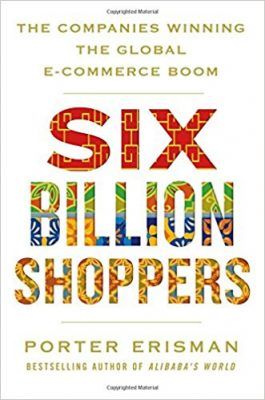
Photo credit: Porter Erisman.
Porter Erisman stood transfixed as he saw a monkey jump atop a pile of dabbas (lunch boxes), trying to prise one of them open, in Mumbai’s teeming Churchgate station. The former Alibaba VP had wanted a first-hand experience of logistics in India and was getting more than he had bargained for. He watched bemused as the dabbawalas (lunchbox delivery men) in crisp white shirts and traditional Gandhi caps finally got the monkey’s handler to distract it, and the entourage could get going.
Dabbawalas carry 130,000 meals each day, mostly in multi-layered steel tiffin carriers, from suburban homes to offices in central Mumbai. It operates on a hub-and-spoke system, with one set of dabbawalas handing off the boxes to the next set. Erisman was shadowing them to understand how it overcomes India’s infrastructure bottlenecks and what made it a Harvard Business Review case study.
I remember my old boss, Jack Ma would say the Amazon model in China was like putting a Rolls Royce jet airplane engine into a hand-glider.
The author of Alibaba’s World and maker of the documentary Crocodile in the Yangtze was researching for his new book Six Billion Shoppers, which was released a month ago. He had joined Alibaba in 2000 when it had just moved out of Jack Ma’s apartment, so he had a pioneer’s view of ecommerce in China. Now he was exploring other emerging markets for insights on new opportunities and evolving models.
From the streets of Mumbai to Thailand’s boat market, parts of the book read like a travelogue. But mostly, it dives into ecommerce strategies across the world, both from a historical perspective as well as conversations with the likes of Flipkart founders Sachin Bansal and Binny Bansal in India and Tokopedia founder William Tanuwijaya in Indonesia.
Erisman looks at new opportunities for local entrepreneurs as well as the battle of the giants in the ecommerce boom towns. “It’s sort of like a cold war where you have the emerging market model of Alibaba competing head-to-head in these markets with the developed country model of Amazon,” he tells Tech in Asia in an in-depth interview.

Porter Erisman with Alibaba boss Jack Ma. [A still from Crocodile in the Yangtze.]
Here are edited excerpts from the chat, interspersed with some explainers for context:
Your book talks of Amazon’s mistake in China. Could you elaborate on that?
Everywhere I went, whether it was India or Southeast Asia or Africa, I saw a common trend – which is that pioneers all tried to apply either the eBay or Amazon model. Even Amazon tried to apply its US model to the China market.
The problem is that to build an Amazon – especially on the original model from the US that was more inventory-led – you need scale and efficiency, both of which are very difficult to get in the early stages of ecommerce in an emerging market. So for example in China, Amazon wanted to apply the US model through their acquisition of the local player [Joyo], but it was difficult because you didn’t have efficient logistics and payment yet. For Amazon to try and manage everything in the whole purchase process was just too expensive.
Jeff Bezos was saying all along that Amazon would not make the same mistakes other US companies made in China, but then they made all the same mistakes.
I remember my old boss, Jack Ma would say it’s like putting a Rolls Royce jet airplane engine into a hand-glider. It’s just too much sophistication and power for something that wasn’t ready for it yet. Jeff Bezos was saying all along that Amazon would not make the same mistakes other US companies made in China, but then they went right into China and made all the same mistakes. I think in India now, where they have a major focus, they’re trying to do it differently.
[To get around India’s restrictions on foreign retailers, Amazon created a marketplace model for India, ostensibly a departure from its inventory-based US model. But it also created subsidiaries Cloudtail and Appario to operate like sellers on the platform and comply with government rules, although it can be viewed as indirectly holding inventories. Indian ecommerce player Flipkart has taken a similar path with its subsidiary seller WS Retail. The marketplace model has proved a blessing for ecommerce growth, helping many brands become online sellers, even though it was initially a response to rules made to pacify offline retailers.]
Alibaba focused on the asset-light C2C (consumer-to-consumer) Taobao marketplace before shifting focus to B2C (business-to-consumer) with Tmall. Is that how it was different from Amazon?
Exactly. In China there’s a saying – “It’s better to be the head of a chicken than a tail of the phoenix.” That means entrepreneurs would rather run their own business, even if it’s making ball bearings, than be working as a middle manager in a big company in China. I see the same thing in India in the spirit of the kirana [small store] – owning a little shop, charting your own destiny, that was the spirit in China of the early ecommerce users.
The big brands and retailers didn’t focus on ecommerce because they looked at this data and said, “If only 1 percent of products in China are bought online, why bother? We’ll just stick with the traditional retail.” So it was the scrappy entrepreneurs who made ecommerce work in China through really a C2C model.
And yet eBay also failed there.
They made the same mistake [as Amazon did later]. When they bought the local player Eachnet in 2003, instead of localizing it to China, they sort of delocalized it. They tried to make it work like eBay in the US, which just didn’t fit the needs of the local entrepreneurs. What the [sellers] wanted was their own shop online, just like they’d have a kirana in India or a small mom-and-pop shop in the street. But eBay tried to lock the users into a system where they couldn’t really communicate with the buyers.
My main thesis of the book is that there’re two models for ecommerce that have emerged. There’s the developed market model which works on a sophisticated infrastructure like in the US and western Europe and maybe Singapore in Asia. But the areas with the most potential are emerging markets, and that requires a different model.
I think Amazon is going to have a better shot in India because they learned from their own mistakes and the mistakes of others.
At the same time, Alibaba has moved more towards branded products and B2C instead of C2C, isn’t it? Because people wanted more quality assurance as purchasing power went up.
Right. China started with C2C and then basically the consumers began to say, “Hey we would like to know we’re getting real products and we’re willing to pay a little extra for that.” And the legitimate sellers were saying, “We want a place where we can sell our products and differentiate ourselves from the cattle feeders.” So that’s why Alibaba created a separate Tmall.
India in some ways managed to skip a phase that China had, going straight to this B2C model with the big marketplaces.
I did think it’s interesting that it wasn’t necessary in some countries. Like in Latin America, there’s not quite as many counterfeits online as in China, so MercadoLibre didn’t have to create this separate environment. And then I think in India, because people saw that Tmall was the big revenue driver in China, the companies really almost started with a sort of Tmall model.
India in some ways managed to skip a phase that China had, going straight to this B2C model with the big marketplaces. But I still think there’s a big C2C opportunity in India because no one has captured the power of the small retailers quite as much.
Once Alibaba moved to the Tmall model, doesn’t it come closer to the more developed market model of Amazon?
In some ways, but here’s the difference – and this I think is the big mistake Amazon is making with its marketplaces outside of the US and Europe […] Amazon is a cold utilitarian platform. If I’m a consumer and I go on to Amazon, I can learn almost nothing about the product.
There’s no real room for brands to create a rich experience and that’s fine in the US where people are already familiar with the brands from other channels. But in a country like China or India where a new middle class is emerging and they are not as familiar with all these new products and brands, it helps for a marketplace to have a dynamic and rich platform that allows branding […] For example, if you go on Tmall in China, brands can put all sorts of videos and product demos and colorful branded content onto the web pages or mobile pages, but Amazon has just a dry minimalistic approach which I don’t think fits emerging markets very well.
Yet India’s ecommerce marketplaces almost mirror Amazon in that, right?
Yeah, this is a mistake I think they’re making. Flipkart you know is a clone of Amazon, all the way from starting as a bookstore to expanding… They’re all trying to build a marketplace, but I don’t think they’re serving the market as well as they could.
See: Thriller to tragedy: India’s failed ecommerce pioneer on what ails Snapdeal
I think what they need is a hybrid of three things: the Amazon model plus the Alibaba model plus an India model. Right now you’re seeing almost too much of an Amazon model in India, so all of these companies are competing with similar models and running huge losses, because that model is not very profitable in the short and medium term and maybe not even in the long term.
What about the JD model in China? They built their own logistics, even if it costs more than the Alibaba way of partnering with third-party providers. In the long run, which works better for consumers as their expectations go up and they have more to spend?
I think that’s still a really open question that I don’t even have a firm answer to. JD’s model, they deserve a lot of credit for, because they started with something where they had to build so much out themselves that they could have easily just gone out of business by burning through cash. But they managed to survive.
If you look out 30 years, the JD model might be the one that ultimately succeeds in China and other emerging markets. It may be that the world is headed towards the JD model or that they have a long-term advantage. But I think it’s an open question because you see all these businesses are actually converging. Like Amazon in the US is now 50 percent marketplace and Alibaba is getting deeper into logistics.
See: Pros and cons for Alibaba in battle with Amazon on neutral ground in India
It appears that the model that will probably prevail in the long run is a marketplace model with a sort of very unified logistics infrastructure that JD has. I think that JD, Amazon, Flipkart – they’re in a lot of ways all going to end in about the same place. The question is who is going to execute better to get there.
In the second part of the interview with Porter Erisman, we will look at the social nature of ecommerce in China, and new opportunities emerging in Southeast Asia.
This post Ex-VP of Alibaba Porter Erisman on clash of ecommerce models in Asia, costly mistakes appeared first on Tech in Asia.
from Tech in Asia https://www.techinasia.com/ex-vp-of-alibaba-porter-erisman-on-the-clash-of-ecommerce-models-in-asia
via IFTTT

No comments:
Post a Comment